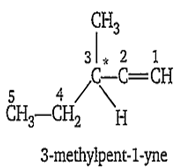 Multiple Choice Questions
Multiple Choice QuestionsAn organic alkadiene on reductive ozonolysis produces
(i) acetaldehyde
(ii) acetone
(iii) 2-methylpropane-1,3-dial
The formula of alkadiene will be
CH3C(CH3)=CHCH(CH3)CH=CHCH3
CH3CH(CH3)CH=C(CH3)CH=CHCH3
CH3C(CH3)=CHCHC(CH3)=CHCH3
CH3CH2CH(CH3)CH=CHC(CH3)=CH2
2-chloro-3-methylbutane is treated with sodium in etherial solution, then it will give
2,4-dimethylhexane
3,5-dimethylhexane
2,3,4,5-tetramethylhexane
2,6-dimethyloctane
Which one of the following hydrocarbons has octane number 100?
2, 2, 3-trimethylpentane
2, 3, 3-trimethylpentane
2, 2, 4-trimethylpentane
2, 3, 4-trimethylpentane
Which one of the following is the best reagent to accomplish the following conversion ?
NaBH3
Na|ether
Zn|C2H5OH
Mg followed by H3O+
Propyne and propene can be distinguished by
conc. H2SO4
Br2 in CCl4
dil. H2SO4
AgNO3 in ammonia
C2H5Cl . This method is
Wurtz synthesis
Kolbe synthesis
Corey House synthesis
Friedel-Craft synthesis
One of the isomer of the 5th member of alkyne series is optically active. It is
4-methyl pent-2-yne
3-methyl pent-1-yne
4-methyl pent-1-yne
3, 3-dimethyl but-1-yne
B.
3-methyl pent-1-yne
3-methyl-pent-1-yne is optically active.

